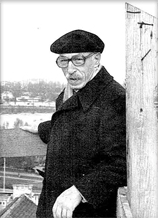
Before WW II
Warsaw before the war
During WWII
Projects done in Warsaw during World War II
After WW II
Rebuilding Warsaw after the Second World War
Memories
Biographies, memorials, family photos etc.
Stanislaw Marzynski (18 may 1904 – 5 february 1992) was a Polish architect, interior designer, writer and educator who designed over 300 major civic structures in Poland, chiefly in Warsaw.
Marzynski believed in designing the buildings in harmony with their culture and setting. He was dedicated to the philosophy of rebuilding historical structures destroyed during World War II and returning them to their original beauty.
This philosophy was best exemplified in his design for the Jesuit church, as well as the Saint Alexander and Saint Florian churches which, along with many others of his buildings, form part of the UNESCO world heritage site in Warsaw’s historical centre.
His professional work includes examples of modern and historical architecture of different building types including churches, palaces, exhibitions, office buildings, residences, monuments and bridges. Marzynski also designed interiors and furniture for several of his structures. He was awarded architectural prizes for the design of the Lazienkowski Bridge among several others.
For over 50 years Marzynski was a professor at the Warsaw Technical University, as well as a leader in educating architects and civil engineers in design thinking and architectural values. He was also an author of textbooks for architectural students.
A soldier in the first and Second World War, Polish-Soviet war in 1920 he and his wife Austrian Hildegarda Marzynska were members of the Polish resistance 1939-1945. He was injured during the Warsaw uprising 1944 and taken as a political prisoner in 1946 for opposing the communist dictatorship.
Marzynski was also a traveler, a photographer, and an accomplished water colorist. He was a founder and member of the Polish association of architects SARP and Solidarity. A recipient of civilian honors, he was made knight of the Ordine di San Gregorio Magno (order of St. Gregory the great) among others.